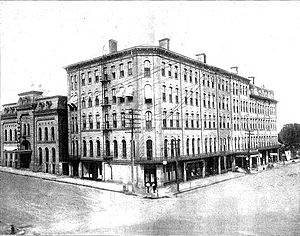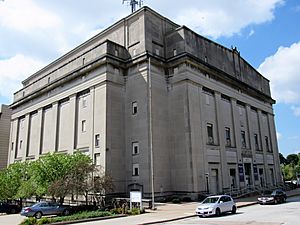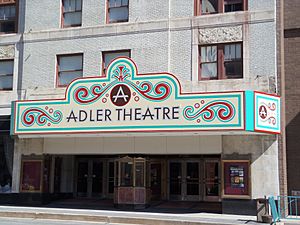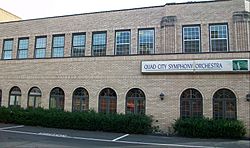Quad City Symphony Orchestra facts for kids
Quick facts for kids Quad City Symphony Orchestra (QCSO) |
|
|---|---|
| Orchestra | |

official logo
|
|
| Former name | Tri-City Symphony |
| Founded | 1916 |
| Location | Davenport, Iowa |
| Principal conductor | Mark Russell Smith |
The Quad City Symphony Orchestra (QCSO) is a professional group of musicians. They play amazing classical music and more! This orchestra is based in Davenport, Iowa, and represents the Quad Cities area.
The current music director and conductor is Mark Russell Smith. The orchestra started way back in 1916. Today, they have a busy schedule! They perform many concerts each year. These include six "Masterworks" concerts with big classical pieces. They also play three "pops" concerts, which are lighter and more popular tunes. Plus, they have five "signature series" chamber concerts, which are smaller shows.
The QCSO has 96 members. They usually play at two main places. One is the Adler Theater in Davenport, Iowa. The other is Centennial Hall at Augustana College in Rock Island, Illinois. Their fun "Riverfront Pops Concert" happens in early September. It's held outdoors at the W.D. Petersen Memorial Music Pavilion in LeClaire Park by the river in Davenport. The "Holiday Pops Concert" is at the Adler Theater. The smaller "signature series" concerts are often held at the Figge Art Museum. The QCSO also helps young musicians. They have four groups for local youth. They also teach music in many schools.
Contents
History of the Orchestra
Starting as the Tri-City Symphony
The orchestra began with a meeting of musicians and citizens. This meeting happened on February 10, 1916. People from Davenport, Rock Island, and Moline came together. They hired Ludwig Becker from Chicago as their first music director. The orchestra's first name was the Tri-City Symphony. The area was called the Tri-Cities back then. It was the smallest community in the United States to have a full symphony orchestra.
The first practice for the orchestra was on March 12, 1916. Their very first concert was on March 29. The orchestra had 60 musicians. Some were amateurs, and some were professionals. About 1,200 people came to the first show. It was held at the Burtis Opera House. This was a vaudeville theater in Davenport. The concert included music by famous composers. These were Wagner, Franz Schubert, and Camille Saint-Saëns. They also played Tchaikovsky's Marche Slav. The orchestra's first "pops" concert was on May 6, 1917. It was held at the Davenport Coliseum.
Even though people loved the orchestra, it had money problems. At first, many musicians were not paid. Members of the local musicians union got a small fee. The number of concerts changed each year. This was because donations went up and down. Some years they played eight concerts. Other years, they played only three. The 1918–19 season was even cancelled. This was due to the economy during World War I. The symphony found it hard to set ticket prices. They wanted to attract audiences. But they also needed to cover their costs. Sometimes, tickets were so cheap that sold-out shows still lost money.
Surviving the Great Depression
The orchestra kept going until the Great Depression. This was a time when many people lost their jobs. The musicians union said their members must be paid. But the symphony did not have enough money. By 1933, they ran out of funds. Most union musicians left the orchestra. They were replaced by people who played music as a hobby. The orchestra could not play its usual complex music. So, they offered free tickets for the 1933–34 season. A few seats were sold for just a quarter. Frank Kendrie became the new music director. He was paid $100 for each concert.
In 1934, Elsie von Maur, a board member, had an idea. She suggested charging what the concerts were truly worth. She also said they should bring back famous guest artists. These changes worked! The orchestra started to make money again. They could hire professional musicians once more. In 1936, the Junior Board was created. This group helped raise money. In 1940, Elsie von Maur became the symphony's first manager. She held this job for 47 years!
Von Maur started a tradition on December 7, 1941. This was the concert after Japan bombed Pearl Harbor. The orchestra played the "Star Spangled Banner". People did not applaud after the song. This tradition of silence after the national anthem started that day. During World War II, students filled in for musicians. Many musicians had joined the military. Unlike the first war, many people still came to concerts. The orchestra even added more shows in 1944.
After World War II and New Name
The symphony was heard across the country in 1948. They had a live concert on NBC radio. It was part of a show called Orchestras of the Nation. Later, Augustana College's radio station (WVIK) started broadcasting the orchestra's concerts. They would play them the week after the live show.
The symphony continued to grow in the 1950s. Concerts moved to Centennial Hall at Augustana College. In the 1960s, concerts were also held at the Masonic Temple in Davenport. In 1976, Lance Willett was hired. He was the first executive director.
In the 1980s, the orchestra moved its main performances. They went to the Adler Theater in Davenport. This theater used to be the RKO Orpheum and was renovated. At the same time, the orchestra changed its name. It became the Quad City Symphony. This name better showed the whole area it served. On October 10, 1996, the symphony played a new piece. It was called Rhapsody for Bix by Lalo Schifrin. This was a tribute to Bix Beiderbecke. He was a famous jazz musician from Davenport. Schifrin himself conducted the orchestra.
On July 3, 2010, the symphony joined the Quad Cities Independence Day party. It was called "Red, White and Boom!". They played a 60-minute pops concert. It was in Davenport's LeClaire Park.
Youth Ensembles
The Quad City Youth Symphony Orchestra started in 1958. It is the top youth orchestra in the area. It helps train young musicians. These musicians are in middle school, junior high, and high school. Students from 22 school districts can join. About 90 musicians play concerts in the fall, winter, and spring. The Youth Philharmonic Orchestra is another group. It is for intermediate players. Members get to play with different instrument groups.
Other groups in the Quad City Youth Ensembles include the Concert Orchestra. This is for string and wind players. It's for those not yet ready for the full symphony's music. The Prelude Strings is an introductory group. It's for students learning violin, viola, cello, or bass. All these groups perform at annual Fall and Winter Concerts. They also play with the Quad City Symphony Orchestra. This special event is called the Side-By-Side Concert.
Volunteers for Symphony
In 1936, the Junior Board was created. Its goal was to raise money for the symphony. In 1957, another group formed. It was called the Tri-City Symphony Auxiliary. This group also supported the orchestra. When the orchestra changed its name, this group did too. It became the Guild of the Quad City Symphony Orchestra.
Both groups joined together in 1996. They formed "Volunteers for Symphony." They organize fun fundraisers. These include the Derby Day Party in May. They also have the Second Fiddle Sale in June. The money they raise helps the symphony's music education programs. These programs are free for students and schools.
Music Directors
Here are the people who have led the Quad City Symphony Orchestra:
- 1916–1933: Ludwig Becker
- 1933–1936: Frank Kendrie
- 1936–1937: Frank Laird Waller
- 1938–1949: Oscar Anderson
- 1949–1954: Harry John Brown
- 1954–1956: Piero Bellugi
- 1956–1965: Charles Gigante
- 1965–1994: James Dixon
- 1995–1997: Kim Allen Kluge
- 1999–2007: Donald Schleicher
- 2008–present: Mark Russell Smith
Guest Artists
Many famous artists have performed with the QCSO. Here is a list of some of them:
|
|






